Don’t Look Now
Zach Feuer
548 West 22nd Street
New York, New York 10011
Runs through July 26, 2014
What’s on view: A show of mostly small, colorful, and cheeky figurative paintings curated by Jesse Greenberg and MacGregor Harp from the Brooklyn/Lower East Side gallery 247365. It looks like NADA all over again! The show’s 19 artists include such familiar names as Brian Belott, Gina Beavers, and Joshua Abelow.
Corinna: I’m not always in love with the silly, sometimes concept-less approach to painting I associate with NADA. But…what an honest press release! This type of art, the curators admit, was “once doomed to languish in obscurity on the walls of coffee shops.” They don’t even try to recover from that jab with, say, some theory to bolster an argument for figurative art: “Simply put, this one is for the picture makers.” That’s enough for me—a simple, straightforward explanation for similarly styled work.
Within the show, there’s paintings of pizza, the Statue of Liberty, birds, a monkey, et cetera. Where these artists are coming from for stock imagery isn’t so far away from say, the cultural imagination of Jeff Koons, but the results couldn’t be more different.
Henry: I have to agree with you on the honesty of the press release. I walked around and saw all the work, and initially I thought the curators were using American iconography to talk pessimistically about the American dream: There’s an embracing family drawn whimsically with scotch tape, a glowing and somewhat forlorn landscape with the statue of liberty, a Cy Twombly-esque painting of what looks like a tax return or maybe some U.S. postage document, a picture of Garfield pulling his own tail.
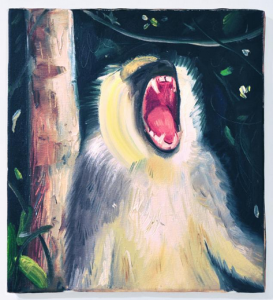
Nikki Maloof’s “Untitled (Night Monkey)”. Image courtesy of Nikki Maloof.
Anyway, I thought the curators were trying to focus their attention on some Americana theme, but that changed once I looked over the press release. Instead the curators just said, “In New York City, a renewed interest in classical themes has emerged—most notably the portrait, the landscape, and the still life.” I’m glad they just took the here’s-what’s-going-on-in-the-art-world route instead of trying to make some sort of social statement, which wouldn’t have worked since all of the pieces are making entirely different statements.
Corinna: I was going to mention this earlier—that Garfield isn’t just having fun. I get where you’re coming from with the pessimistic take on middlebrow culture. There’s rough marks on the canvas where his background could be; instead, it’s like he’s been forsaken, left to continue at his thankless task forever. Add to that existential loneliness Nikki’ Maloof’s endlessly screaming monkey or Keith Mayerson’s Statue of Liberty stuck in an apocalyptic purple sky.
Florian Maier-Aichen
303 Gallery
507 West 24th Street
New York, NY 10011
Runs through July 25, 2014
What’s on view: Messy, colorful abstractions that mix photography and painting, and some very large landscape photographs.
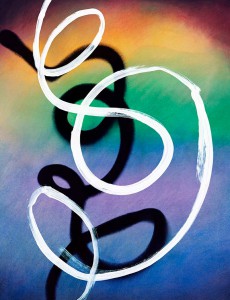
Florian Maier-Aichen’s “Untitled.” Image courtesy of 303 Gallery.
Andrew: This show totally missed the mark for me. The press release spends a lot of time talking about process and the fact that the works are made by mixing photography and painting (the works are made by photographing transparent cels of painted marks) to try and justify the images. But a complex process can’t save bland abstractions. As for the landscape photographs, I was totally confused by how they related to the rest of the show.
Corinna: My main concern with this show: Not much can be said for someone who makes c-prints of painted squiggles on top of colorful abstract backgrounds. You look at them and the only reveal is that “Ooohh, these are actually just photographs.” That’s not much of a reveal. Unlike the works on view at Hauser & Wirth, that explore photography’s physical side with actual objects, these works just fall prey to decoration. Enough with this type of photography already!
Ed Paschke
Mary Boone Gallery
541 West 24th Street
New York, NY 10011
Runs through July 18, 2014
(Dates have been extended from June 28 closing listed on the Mary Boone site.)
What’s on view: The late Ed Paschke’s electric-colored canvases featuring cyborgs, celebrities, and outcasts. Trippy Americana, like rockabilly and tattoos, occult hand signs, guns, and sacred hearts make a surreal, occult version of mainstream and underground culture.
Corinna: “Ed who?” I remember thinking when I first moved to Chicago. I wasn’t sure if this was the name of an artist or a used car salesman. Soon after, I received a near-daily education about Ed Paschke, Roger Brown, Christina Ramberg—the whole lot of Chicago Imagists. He’s very important over there.
Whitney: After this show, I kind of get why. A really compelling violent undercurrent runs through almost all the work—Osama Bin Laden peers out from between two wallpaper panels, pointed fingers and guns seem to accuse and threaten people, and face masks and tattoos look like white fear. The collage tactics work better sometimes than others; I’m not convinced there’s much added when he circles a nose in an image of a nose and mouth. But “Allez Vous-En,”an image of (Bing Crosby?) calmly leaning forward, with light rays emanating from a sacred heart on his lapel does work. Pointing at him are a stack of hands counting down one, two, three, four, and five on their fingers. The clash between the hands and the blonde singer’s serene expression captures a quasi-violent religious pop worship.
Corinna: I wasn’t immediately convinced; Paschke isn’t an artist you can learn to like just by looking at his paintings online. It’s his cyborg/surveillance works that really get to me, although I didn’t like them too much at first. Back then, I would’ve thought a work like “Avril” (1991) was too stuck on Bladerunner, with a rasterized canvas and day-glo treatment. I don’t know what changed, exactly, other than seeing more of his work in person. Somehow I ended up re-seeing Paschke’s methods as tools; tools, that create a frightening universe where people are just body parts afflicted by scanners and radar. Not all his works do that, though. The Shakespeare and bin Laden portraits certainly didn’t.
Paddy: I don’t know if I agree that the work doesn’t reproduce well; the main reason I was interested in this show was because of Robin Dluzen’s review on AFC and all the images I’d paged through. They have a poster-like quality to them and he’s not the kind of artist who’s all about the paint handling. He prefers a smooth surface and close up examination often doesn’t yield much additional detail. That’s not a criticism. You don’t need fancy brushwork to better a pairing of a wallpaper rorschach and a boxer, or a masked robber that looks as though he’s being eaten by the pattern of his sweater. Formally I think the work is beautiful, and re-enforces some of the violent themes Whitney identified.
By and large this is creepy stuff and women don’t play more than a decorative function in the paintings. They are literally topless trim in Third Word. Blanco, which thankfully isn’t in the show, transforms a woman’s head into a vagina. Her torso is all boobs. The palette and other subject matter makes me wonder if this isn’t just boyish imagination at work, but still. I could do without it.

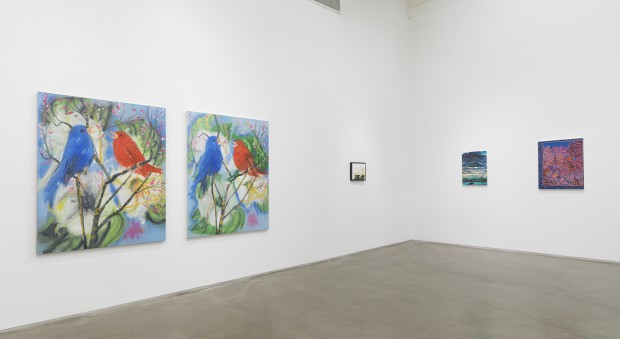
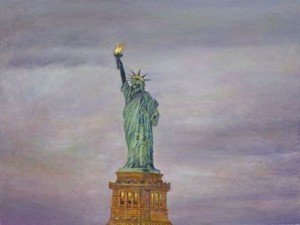
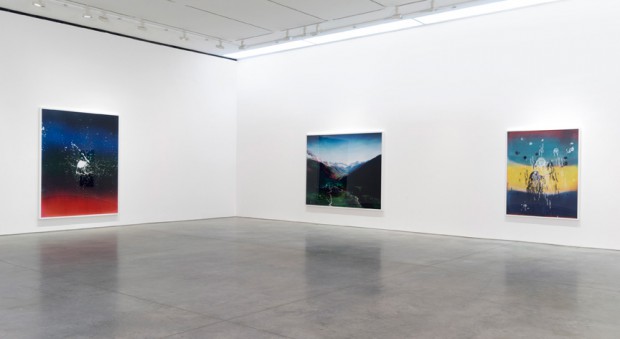
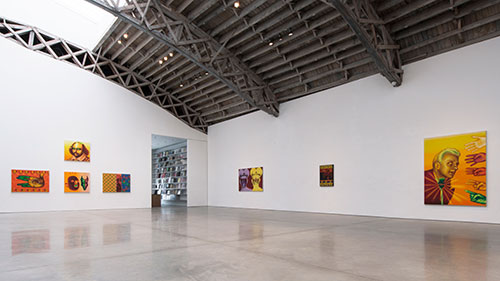
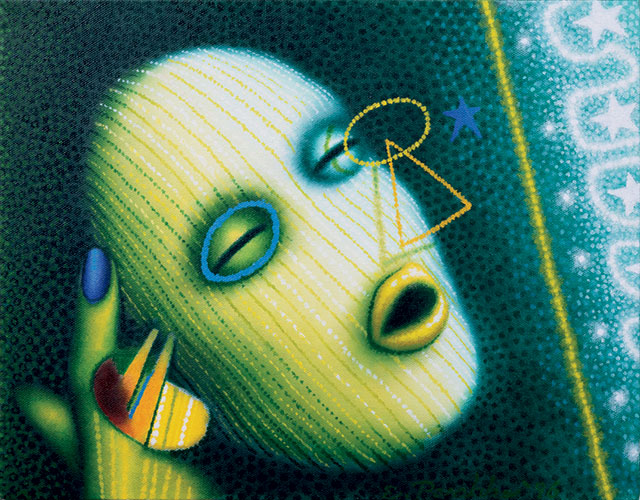


Comments on this entry are closed.